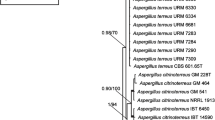Abstract
Isolates representing newly described Neosartorya species, and isolates with abnormal morphologies from Aspergillus section Fumigati were examined by phylogenetic analysis of sequences of part of their β-tubulin gene. Phylogenetic analyses supported the earlier suggestions that heterothallism is a derived character, and that sexuality was lost several times during the evolution of Aspergillus section Fumigati. The heterothallic N. fennelliae and N. udagawae strains were found to be closely related to the homothallic Neosartorya sp. NRRL 4179 and N. aureola, respectively. Aspergillus sp. FRR 1266, which was earlier described as a variant of A. fumigatus, was found to be closely related to A. viridinutans. Another abnormal asexual isolate was found to be closely related to A. fumigatus and N. fischeri. Phylogenetic relationships among newly described Neosartorya species and other taxa were successfully established based on phylogenetic analysis of β-tubulin sequences.
Similar content being viewed by others
References
Abarca ML, Bragulat MR, Castellá G, Accensi F & Cabañes FJ (1997) New ochratoxigenic species in the Aspergillus genus. J. Food Prot. 60: 1580–1582
Felsenstein J (1985) Confidence limits on phylogenies: an approach using the bootstrap. Evolution 39: 783–791
Felsenstein J (1995) PHYLIP (Phylogeny Inference Package). Version 3.57c. Distributed by the author. Department of Genetics, University of Washington, Seattle
Fitch WM & Margoliash E (1967) Construction of phylogenetic trees. Science 155: 279–284
Frisvad JC & Samson RA (1990) Chemotaxonomy and morphology of Aspergillus fumigatus and related taxa. In: Samson RA & Pitt JI (Eds) Modern concepts in Penicillium and Aspergillus classification (pp 201–208). Plenum Press, New York
GamsW, Christensen M, Onions AHS, Pitt JI & Samson RA (1985) Infrageneric taxa of Aspergillus. In: Samson RA & Pitt JI (Eds) Advances in Penicillium and Aspergillus systematics (pp 55–61). Plenum Press, New York
Geiser DM, Frisvad JC & Taylor JW (1998) Evolutionary relationships in Aspergillus section Fumigati inferred from partial β-tubulin and hydrophobin DNA sequences. Mycologia 90: 831–845
Girardin H, Monod M & Latgé J-P (1995) Molecular characterization of the food-borne fungus Neosartorya fischeri (Malloch and Cain). Appl. Environ. Microbiol. 61: 1378–1383
Horie Y, Miyaji M, Nishimura K, Franco MF & Coelho KIR (1995a) Two new species of Neosartorya from Brazilian soil. Mycoscience 36: 159–165
Horie Y, MiyajiM, Nishimura K, Franco MF & Coelho KIR (1995b) New and interesting species of Neosartorya from Brazilian soil. Mycoscience 36: 199–204
Horie Y, Miyaji M, Yokoyama K, Udagawa S-I & Campos-Takagi GM (1992) Neosartorya tatenoi, a new species from Brazilian soil. Trans Mycol. Soc. Japan 33: 395–399
Katz ME, Mcloon M, Burrows S & Cheetham BF (1998) Extreme DNA sequence variation in isolates of Aspergillus fumigatus. FEMS Immunol. Med. Microbiol. 20: 283–288
Kimura M (1980) A simple method for estimating evolutionary rate of base substitutions through comparative studies on nucleotide sequences. J. Mol. Evol. 2: 87–90
Kozakiewicz Z (1989) Aspergillus species on stored products. Mycological Papers 161: 1–188
Leach J, Finkelstein DB & Rambosek JA (1986) Rapid miniprep of DNA from filamentous fungi. Fungal Genet. Newslett. 33: 32–33
Malloch D & Cain RF (1972) The Trichocomaceae: ascomycetes with Aspergillus, Paecilomyces, and Penicillium imperfect states.Can. J. Bot. 50: 2613–2628
Peterson SW (1992) Neosartorya pseudofischeri sp. nov. and its relationship to other species in Aspergillus section Fumigati. Mycol. Res. 96: 547–554
Pontecorvo G, Roper JA, Hemmons LM, MacDonald KD & Bufton AWJ (1953) The genetics of Aspergillus nidulans. Adv. Genet. 5: 141–238
Raper KB & Fennell DI (1965) The genus Aspergillus. Williams & Wilkins, Baltimore
Rinyu E, Varga J & Ferenczy L (1995) Phenotypic and genotypic analysis of variability in Aspergillus fumigatus. J. Clin. Microbiol. 33: 2567–2575
Sambrook J, Fritsch EF & Maniatis T (1989) Molecular cloning. A laboratory manual. Second edition. Cold Spring Harbor Laboratory Press, Cold Spring Harbor, New York
Samson RA (1994) Current systematics of the genus Aspergillus. In: Powell KA, Renwick A & Peberdy JF (Eds) The genus Aspergillus: from taxonomy and genetics to industrial applications (pp 261–276). Plenum Press, New York
Samson RA, Nielsen PV & Frisvad JC (1990) The genus Neosartorya: differentiation by scanning electron microscopy and mycotoxin profiles. In: Samson RA & Pitt JI (Eds) Modern concepts in Penicillium and Aspergillus classification (pp 455–476). Plenum Press, New York
Udagawa S-I, Toyazaki N & Tsubouchi H (1993) Neosartorya primulina, a new species of food-borne Ascomycetes. Mycotaxon 47: 359–366
Varga J, Rinyu E, Kiss I, Botos B & Kozakiewicz Z (1997) Carbon source utilization and isoenzyme analysis as taxonomic aids for toxigenic Neosartorya species and their relatives. Acta Microbiol. Immunol. Hung. 44: 1–11
Yaguchi T, Someya A & Udagawa S-I (1994) A new species of Neosartorya from Taiwan soil. Mycoscience 35: 309–313
Author information
Authors and Affiliations
Corresponding author
Rights and permissions
About this article
Cite this article
Varga, J., Vida, Z., Tóth, B. et al. Phylogenetic analysis of newly described Neosartorya species. Antonie Van Leeuwenhoek 77, 235–239 (2000). https://doi.org/10.1023/A:1002476205873
Issue Date:
DOI: https://doi.org/10.1023/A:1002476205873




